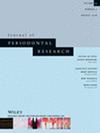Unveiling the consequences of early human saliva contamination on membranes for guided bone regeneration
Abstract
Aims
GBR membranes have various surface properties designed to elicit positive responses in regenerative clinical procedures; dental clinicians attempt to employ techniques to prevent the direct interaction of contaminated oral fluids with these biomaterials. However, saliva is uninterruptedly exhibited in oral surgical procedures applying GBR membranes, suggesting a persistent interaction with biomaterials and the surrounding oral tissues. This fundamental study aimed to investigate potential alterations in the physical, chemical, and key biological properties of membranes for guided bone regeneration (GBR) caused by isolated early interaction with human saliva.
Methods
A reproducible step-by-step protocol for collecting and interacting human saliva with membranes was developed. Subsequently, membranes were evaluated for their physicochemical properties, protein quantification, DNA, and 16S rRNA levels viability of two different cell lines at 1 and 7 days, and ALP activity. Non-interacted membranes and pure saliva of donors were applied as controls.
Results
Qualitative morphological alterations were noticed; DNA extraction and 16S quantification revealed significantly higher values. Furthermore, the viability of HGF-1 and MC3T3-E1 cells was significantly (p < .05) reduced following saliva interaction with biodegradable membranes. Saliva contamination did not prejudice PTFE membranes significantly in any biological assay.
Conclusions
These outcomes demonstrated a susceptible response of biodegradable membranes to isolated early human saliva interaction, suggesting impairment of structural morphology, reduced viability to HGF-1 and MC3T3-E1, and higher absorption/adherence of DNA/16S rRNA. As a result, clinical oral procedures may need corresponding refinements.


 求助内容:
求助内容: 应助结果提醒方式:
应助结果提醒方式:


